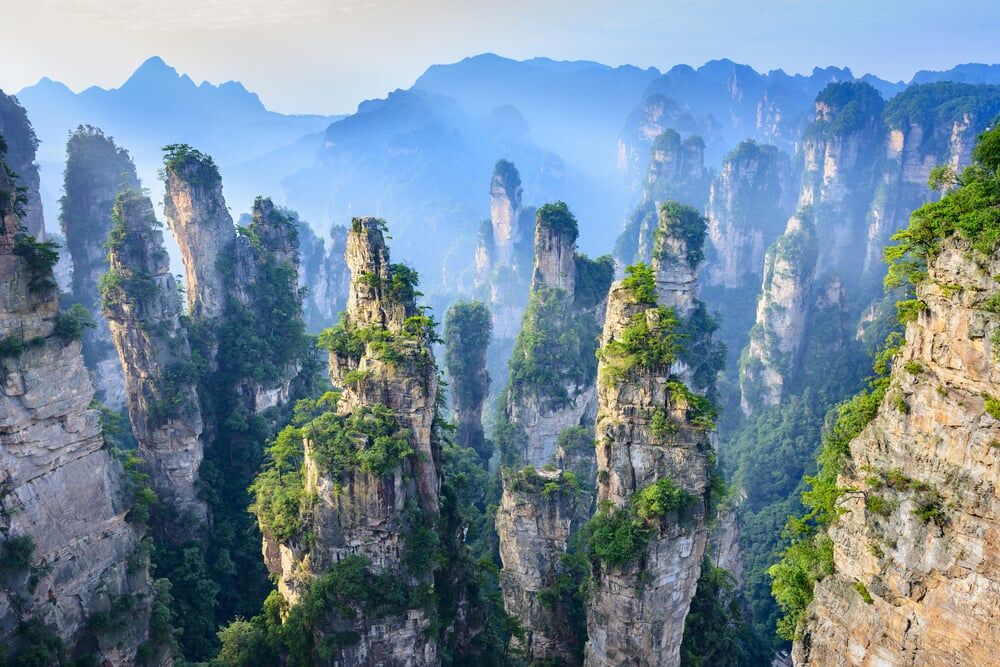
How Was Zhangjiajie National Forest Park Formed?
Zhangjiajie National Forest Park, located in northwestern Hunan, China, is renowned for its towering sandstone pillars that appear to defy gravity. These unique geological formations are the result of a fascinating and lengthy process that spans millions of years. Here's a glimpse into the formation of this natural wonder:
1. Formation of the Quartz Sandstone "Eggs" (1.5 Billion Years Ago)
The story of Zhangjiajie begins approximately 1.5 billion years ago during the Proterozoic Eon. At this time, the Earth's crust in this region experienced powerful tectonic movements. These movements led to the formation of a deep sea trough, creating an ideal environment for what would become the foundation of Zhangjiajie's iconic peaks.
Underwater volcanic activity played a crucial role in this stage. Eruptions spewed lava rich in quartz onto the seabed. As the lava cooled and solidified, it crystallized into durable quartz sandstone. These sandstone deposits became the "eggs," the raw material, from which the future sandstone peaks would be sculpted.
2. Uplift and Exposure of the Sandstone (400 Million Years Ago)
Over a vast period, layers of sediment accumulated over the quartz sandstone. The weight of these layers, combined with ongoing tectonic forces, caused the entire region to rise above sea level around 400 million years ago.
This uplift had two significant effects:
- Exposure: The quartz sandstone "eggs" were gradually exposed to the elements as overlying sedimentary layers eroded away.
- Fracturing: The uplift also created stresses and fractures within the sandstone, making it more susceptible to the forces of weathering and erosion.
3. Sculpting by Nature's Forces (Millions of Years)
The exposed sandstone became a canvas for nature's artistic prowess. Over millions of years, weathering and erosion worked in concert to carve the sandstone into the breathtaking formations we see today. Here are the primary agents of change:
- Water: Rainwater, slightly acidic due to dissolved carbon dioxide, seeped into the cracks and crevices of the sandstone. Over time, this acidic water dissolved the quartz, widening the cracks and gradually breaking down the rock.
- Ice: In colder periods, water trapped within the sandstone froze and expanded, acting like tiny wedges that further fractured the rock.
- Wind: Wind, carrying abrasive particles, sandblasted the exposed surfaces, slowly etching away at the sandstone and contributing to the unique shapes.
- Plants: Plant roots, seeking water and nutrients, grew into the cracks, widening them and accelerating the breakdown process.
4. The Emergence of the Peak Forest Landscape
The combined effects of these natural forces, acting over millions of years, resulted in the awe-inspiring landscape of Zhangjiajie National Forest Park:
- Towering Pillars: The more resistant areas of quartz sandstone, often the "eggs" formed from ancient lava, withstood erosion better, forming the towering pillars that define the park.
- Deep Ravines and Valleys: The areas where the sandstone was more easily eroded were carved away, creating the deep ravines and valleys that weave between the pillars.
Timeline of Zhangjiajie's Formation
| Era | Period | Time (Million Years Ago) | Event |
|---|---|---|---|
| Precambrian | Proterozoic | 1500 | Formation of quartz sandstone "eggs" from underwater volcanic activity |
| - | 1500 - 400 | Sedimentation and burial of the sandstone | |
| Paleozoic | Devonian | 400 | Uplift of the region, exposing the sandstone to the elements |
| Cenozoic | Paleogene | 66 - 23 | Intensified weathering and erosion begin sculpting the landscape |
| Neogene | 23 - 2.6 | Continued erosion shapes the peaks and valleys | |
| Quaternary | 2.6 - Present | Ongoing weathering and erosion refine the landscape, including the influence of ice ages. |
Q&A
Q1: What type of rock forms the pillars in Zhangjiajie? A1: The pillars are composed primarily of quartz sandstone.
Q2: What role did volcanic activity play in the park's formation? A2: Underwater volcanoes erupted lava rich in quartz, which solidified into the quartz sandstone that forms the base material of the peaks.
Q3: What is the most significant natural force that continues to shape Zhangjiajie today? A3: While wind, ice, and plants all play a role, water erosion, particularly rainwater dissolving the sandstone, remains the most dominant force shaping the park today.